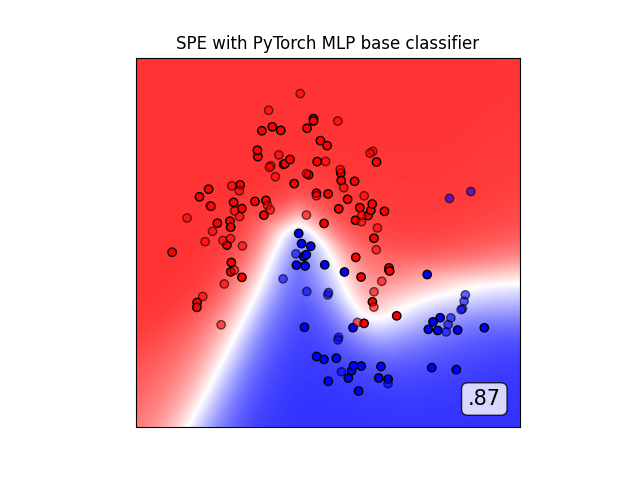Note
Go to the end to download the full example code
Classification with PyTorch Neural Network
An example of how to cooperate imbens with deep learning frameworks like PyTorch.
In this example, we first define a simple MLP classifier using PyTorch, and pack
it into a scikit-learn-style wrapper class TorchMLPClassifier. We then use it as
the base estimator of imbens.ensemble.SelfPacedEnsembleClassifier and
train the ensemble on a toy imbalanced dataset.
This example uses:
# Authors: Zhining Liu <zhining.liu@outlook.com>
# License: MIT
print(__doc__)
# Import imbalanced-ensemble
import imbens
# Import pytorch and numpy
import torch
import torch.nn as nn
import numpy as np
# Import utilities
import sklearn
from sklearn.datasets import make_moons
from sklearn.model_selection import train_test_split
from sklearn.preprocessing import StandardScaler
from imbens.datasets import make_imbalance
# Import plot utilities
import matplotlib.pyplot as plt
from matplotlib.colors import ListedColormap
RANDOM_STATE = 42
PyTorch MLPClassifier
Define a simple 3-layer perceptron with PyTorch.
class MLP(nn.Module):
def __init__(self, input_size, hidden_size, output_size):
super(MLP, self).__init__()
self.fc1 = nn.Linear(input_size, hidden_size)
self.fc2 = nn.Linear(hidden_size, output_size)
self.relu = nn.ReLU()
def forward(self, x):
out = self.fc1(x)
out = self.relu(out)
out = self.fc2(out)
return out
Wrap the MLP into a scikit-learn-style ``TorchMLPClassifier`` class.
class TorchMLPClassifier(sklearn.base.BaseEstimator, sklearn.base.ClassifierMixin):
def __init__(
self,
input_size,
hidden_size,
output_size,
learning_rate=0.01,
num_epochs=50,
batch_size=32,
):
self.input_size = input_size
self.hidden_size = hidden_size
self.output_size = output_size
self.learning_rate = learning_rate
self.num_epochs = num_epochs
self.batch_size = batch_size
self.model = MLP(input_size, hidden_size, output_size)
def _validate_input(self, X, y):
X, y = self._validate_data(
X,
y,
accept_sparse=["csr", "csc"],
multi_output=True,
dtype=(np.float64, np.float32),
reset=True,
)
self.classes_ = sklearn.utils.multiclass.unique_labels(y)
return X, y
def fit(self, X, y):
X, y = self._validate_input(X, y)
# Convert data to PyTorch tensors
X_tensor = torch.tensor(X, dtype=torch.float32)
y_tensor = torch.tensor(y, dtype=torch.long)
# Define loss function and optimizer
criterion = nn.CrossEntropyLoss()
optimizer = torch.optim.Adam(self.model.parameters(), lr=self.learning_rate)
# Train the model
for epoch in range(self.num_epochs):
for i in range(0, len(X), self.batch_size):
# Forward pass
outputs = self.model(X_tensor[i : i + self.batch_size])
# Compute loss
loss = criterion(outputs, y_tensor[i : i + self.batch_size])
# Backward and optimize
optimizer.zero_grad()
loss.backward()
optimizer.step()
def predict(self, X):
# Convert data to PyTorch tensor
X_tensor = torch.tensor(X, dtype=torch.float32)
# Forward pass and get predictions
outputs = self.model(X_tensor)
_, predicted = torch.max(outputs.data, 1)
# Convert predictions to numpy array and return
return predicted.numpy()
def predict_proba(self, X):
# Convert data to PyTorch tensor
X_tensor = torch.tensor(X, dtype=torch.float32)
# Forward pass and get softmax probabilities
outputs = self.model(X_tensor)
softmax = nn.Softmax(dim=1)
probabilities = softmax(outputs).detach().numpy()
# Return probabilities
return probabilities
Classification and Visualization
Prepare the class-imbalanced toy dataset.
# imbalanced moons dataset
distribution = {0: 100, 1: 50}
X, y = make_moons(200, noise=0.2, random_state=RANDOM_STATE)
imb_moons_dataset = make_imbalance(
X, y, sampling_strategy=distribution, random_state=RANDOM_STATE
)
classes = sklearn.utils.multiclass.unique_labels(y)
Use the ``TorchMLPClassifier`` as the ensemble base estimator.
torch_spe = imbens.ensemble.SelfPacedEnsembleClassifier(
estimator=TorchMLPClassifier(
input_size=X.shape[1], hidden_size=64, output_size=classes.shape[0]
),
n_estimators=10,
)
Visualize function.
def plot_classification_result(dataset, clf, **axset_kwargs):
h = 0.01 # step size in the mesh
cm_bright = ListedColormap(['#FF0000', '#0000FF'])
# Normalize and split the dataset
X, y = dataset
X = StandardScaler().fit_transform(X)
X_train, X_test, y_train, y_test = train_test_split(
X, y, test_size=0.4, random_state=42
)
# Prepare the meshgrid for plotting
x_min, x_max = X[:, 0].min() - 0.5, X[:, 0].max() + 0.5
y_min, y_max = X[:, 1].min() - 0.5, X[:, 1].max() + 0.5
xx, yy = np.meshgrid(np.arange(x_min, x_max, h), np.arange(y_min, y_max, h))
clf.fit(X_train, y_train)
score = sklearn.metrics.average_precision_score(y_test, clf.predict(X_test))
# Plot the decision boundary. For that, we will assign a color to each
# point in the mesh [x_min, x_max]x[y_min, y_max].
if hasattr(clf, "decision_function"):
Z = clf.decision_function(np.c_[xx.ravel(), yy.ravel()])
else:
Z = clf.predict_proba(np.c_[xx.ravel(), yy.ravel()])[:, 1]
# Put the result into a color plot
Z = Z.reshape(xx.shape)
ax = plt.gca()
ax.imshow(
-Z, extent=(xx.min(), xx.max(), yy.max(), yy.min()), cmap='bwr', alpha=0.8
)
# Plot the training points
ax.scatter(X_train[:, 0], X_train[:, 1], c=y_train, cmap=cm_bright, edgecolors='k')
# Plot the testing points
ax.scatter(
X_test[:, 0], X_test[:, 1], c=y_test, cmap=cm_bright, edgecolors='k', alpha=0.6
)
ax.set_xlim(xx.min(), xx.max())
ax.set_ylim(yy.min(), yy.max())
ax.set_xticks(())
ax.set_yticks(())
ax.text(
0.95,
0.06,
('%.2f' % score).lstrip('0'),
size=15,
bbox=dict(boxstyle='round', alpha=0.8, facecolor='white'),
transform=ax.transAxes,
horizontalalignment='right',
)
ax.set(**axset_kwargs)
return ax
Visualize the classification result.
ax = plot_classification_result(
imb_moons_dataset, torch_spe, title='SPE with PyTorch MLP base classifier'
)

Total running time of the script: ( 0 minutes 4.181 seconds)